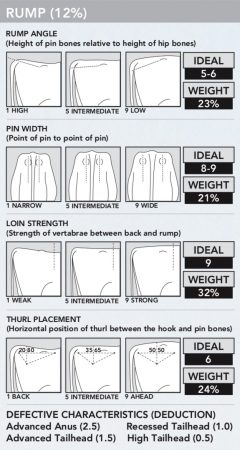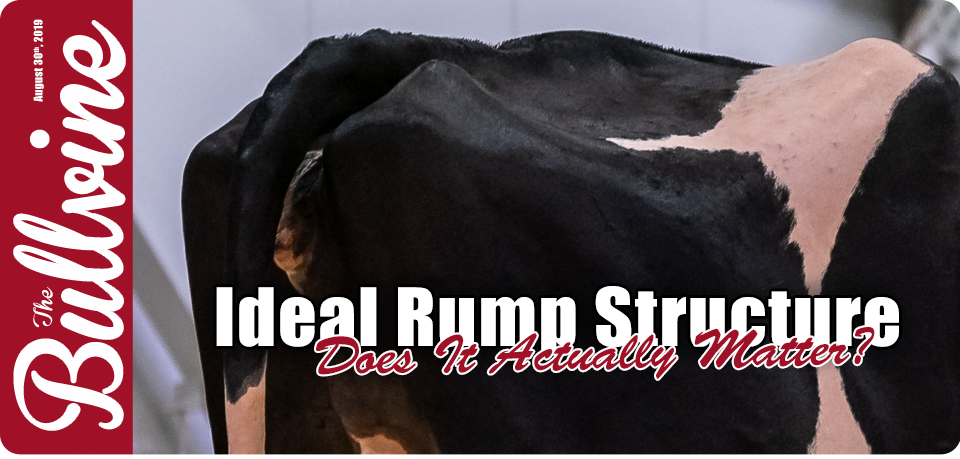Classifiers and show judges evaluate and compare cow body parts for their structure according to the breed conformation scorecard and breed ideals. Yet, yield and profit focused breeders and A.I. are now selecting based on the proven science of the functionality of body parts. This Bullvine article addresses the documented facts on Holstein cows’ rumps. Which rump traits need to be left behind? Which rump related trait indexes need to be used in over ninety percent of dairy herds when selecting and mating sires?

Source: Holstein Canada
What Do Breed Ideal Rumps Look Like?
Both US and Canadian Holstein Breeds describe the ideal rumps as being long, wide, pins slightly lower than hips, neither anus or tailhead recessed, freedom from coarseness, etc. … so as to have rumps that facilitate easier calvings and that assist with improved cow fertility, healthy recovery after calving and increased cow longevity.
But do those descriptions hold up, when it comes to what happens in the field?
Additionally, which is the correct emphasis on the rump – US at 5 point out of 100 or Canada at 12 points? In the showring it is the author’s observation that judges often place more than 20 points on the rump when giving reasons for their class placings.
The Evolution of Holstein Rumps
Very old cow pictures often show cows that were very, even extremely, sloped from hips to pins. Somewhat like what we see in today’s native wild deer populations.
By the early to mid-twentieth century the desired rump was wide, pins level with hips and tail heads between the pin bones on cows of about 53” – 55” in stature.
Then it was decided that Holstein cows needed to be taller. Much taller by the 1980’s. This tallness and the popular bloodlines seem to have brought with them narrower animals, narrower rumps or smaller pelvis openings and more difficult birthing. An added negative was that breeders wanted larger calves, feeling that larger birth size lead to larger mature animals. In fact, that is not universally the case.
Thank goodness reason is winning out for moderated stature and what size healthy calves need to be.
What Do Results Say About Today’s Ideal Rumps?
Published Canadian (CDN) genetic correlations provide information on rump traits that dairy breeders need to be aware of. These results are based on 4,182 Holstein sires proven between 2003 and 2018.
The genetic correlations to longevity (Herd Life) by the classified traits are: rump angle (0.12), pin width (-0.08), loin strength (0.04), thurl placement (0.18) and overall rump (0.15).
The genetic correlations to fertility (Daughter Fertility) by classified traits are: rump angle (0.04), pin width (-0.06), loin strength (-0.10), thurl placement (0.06) and overall rump (-0.01).
Remember that the breed societies say the ideal rumps lead to improved longevity and fertility – but with those low correlations it just isn’t so.
The conclusion this author draws is that the rump traits, as captured by the type classification programs, do not contribute positively to either longevity or fertility in Canadian Holsteins. Correlations using US data do not appear to be available on the www.
How Important Are Rumps?
How often in a cow’s lifetime can rump structure be a limiting factor?
Consider a cow that first calves at 23 months and completes four lactations and is removed from the herd at 75 months of age. Put on a functioning basis, this means she calves on four days (0.002% of her days), walks on her feet and legs for 2280 days (100% of her days), milks for 1430 days (62.7% of her days) and is dry for 150 days (6.5% of her days).
Draw your own conclusions. However for this author rump structure ranks far far behind feet and legs (foot structure, rear-legs-rear-view, flex of hock and mobility) and mammary system (depth, cleft, teat placement and attachments) when it comes to deserving attention when selecting sires to be used in herds that focus on profitably producing milk solids.
What Really Counts in Rumps?
Rumps that function best allow for quick, easy births, fast recovery of the mother and a healthy calf with minimal stress. For the dam side of this, it is best measured by farmer supplied measurements on her calving ease – Daughter Calving Ease (USA) and Daughter Calving Ability (CAN). For the calf side of this the sire’s calving ease is important – Calving Ease (USA) and Calving Ability (CAN). In the USA, CA$’s are published for animals which combines information on both calving ease and stillbirths.
The Canadian correlations for proven sires, for the study referred to above, are as follows: for longevity (Herd Life) with sire calving ability (0.25) and daughter calving ability (0.43); and for fertility (Daughter Fertility) with sire calving ability (0.14) and daughter calving ability (0.40).
By a considerable amount (2x to 10x) daughter calving ability is a superior index to all the classified rump traits in predicting longevity and fertility in Canadian Holsteins. Although farm captured data does not exist for calf health at one week of age, it is likely that daughter calving ability is at least moderately correlated to calf health and wellbeing.
Why the Fixation with Rumps?
The short answer may have two parts:
1) Tradition – when other more accurate measures were not available, then visual observation of the exterior was the best tool available; and
2) Sight line and proximity – breeders’, classifiers’ and show judges’ eyes, when viewed from the rear of an animal, are at the same level at the rump.
Take Home Messages
- Daughter Calving Ease (DCE or DCA) is the best predictor that currently exists for the best rumps.
- Holsteins are improving for Daughter Calving Ease, but breeders will be well rewarded for continuing to use sires that are rated above average for CA$, DCE or DCA.
- The bull Oman was a great help for the Holstein breed being able to reduce calving difficulties.
- AI. organizations publish CE’s and DCE’s for their sires and most no longer sample or market sires that leave calves that are born with difficulty.
- Sire rump type indexes are not good predictors of daughter calving ease.
The Bullvine Bottom Line
Current Holstein breed ideals and standards for rump structure and the emphasis placed on rumps in the type classification programs are only of quite limited value for most herds. Outside rump appearance bears little value in predicting calving ease, longevity and fertility.
Conformation evaluations need to include the functioning of the body part and not simply the appearance. Rumps could be a good place for breeds to start in revamping their type classification programs in order to remain relevant to tomorrow dairy farmers’ needs.
Get original “Bullvine” content sent straight to your email inbox for free.

















